Geoscience Reference
In-Depth Information
Table 3.1
Petrophysical properties of the soil used to solve the
seismoelectric coupling.
1250
First longitudinal wave P1
Property
Symbol
Value
1200
Bulk modulus of air
K
1
(MPa)
0.145
1150
Bulk modulus of framework
K
b
(GPa)
1.02
Bulk modulus of solid
K
s
(GPa)
35
Bulk modulus of water
K
2
(GPa)
2.25
1100
Fitting parameter
n
(
—
)
2.03
Fitting parameter
η
0.5
Fitting parameter
(
—
)
2.39
χ
8
Second longitudinal wave P2
ρ
1
(kg m
−
3
)
Material density of air
1.1
(kg m
−
3
)
Material density of solid
ρ
s
2650
6
ρ
2
(kg m
−
3
)
Material density of water
997
(m
2
)
10
−
12
Permeability
k
4
Porosity
ϕ
(—)
0.23
Shear modulus of framework
G
(GPa)
1.44
2
η
1
(Ns m
−
2
)
18 × 10
−
6
Viscosity of air
2
(Ns m
−
2
)
Viscosity of water
η
0.001
0
0.05
Third longitudinal wave P3
existence of three compressional waves in a poroelastic
medium saturated by two immiscible fluids. According
to the numerical analysis conducted by Vasco and
Minkoff (2012), Lo et al. (2005), Santos et al. (1990,
2006), and Tuncay and Corapcioglu (1997), the P1 and
P2 waves correspond to the fast and slow compressional
waves in the Biot (1962a, b) model. The third wave (P3)
is a diffusive wave that is due to the pressure difference
between the fluid phases, and its phase speed depends
on the slope of the capillary pressure effect. We solved
the polynomial (Eq. 3.163) in the low-frequency region
for an air
0.04
0.03
0.02
0.01
0
0
0.1
0.2
0.3
0.4
0.5
0.6
0.7
0.8
0.9
1
Water saturation
Figure 3.1
Effect of water saturation on the three-phase
velocities of the longitudinal mode wave propagation as derived
from the real component of the roots of cubic Equation (3.163)
with 10 Hz as the source frequency used in the numerical model.
water mixture, to study the effect of water sat-
uration on the velocity of the three wave modes using the
poroelastic parameters noted in Table 3.1. The results
obtained are reported in Figure 3.1 and show that for
the first, fast P-wave, there is a decrease in compressional
wave velocity with water saturation. The velocity
decreases with increasing water saturation because total
density increases (Lo et al., 2005). At very high water sat-
uration, the compressional velocity is more controlled by
the fluid bulk modulus H than bulk density. The velocity
of the first wave, P1, in the low-frequency condition can
be determined from the following formulation (Lo
et al., 2005):
-
where
H
=
a
11
+
a
22
+
a
33
+2
a
12
+
a
13
+
a
23
. The second
dilatational wave (P2) propagates as a diffusion wave
(Biot, 1956a, b; Santos et al., 1990; Tuncay &
Corapcioglu, 1997) in which its velocity increases for a
fully saturated soil. The third mode of propagation P3 is
shown in Figure 3.1 to have the lowest velocity and is
caused by the pressure difference between the two fluid
phases. The third wave does not occur in systems with a
single fluid. The attenuation coefficients derived from the
imaginary part of the velocity for the three wave modes
are plotted in Figure 3.2 where it is shown that the atten-
uation increases with water saturation for the P1 wave;
however, its attenuation is much lower relative to the
H
ρ
T
c
pI
=
3 164










































































































